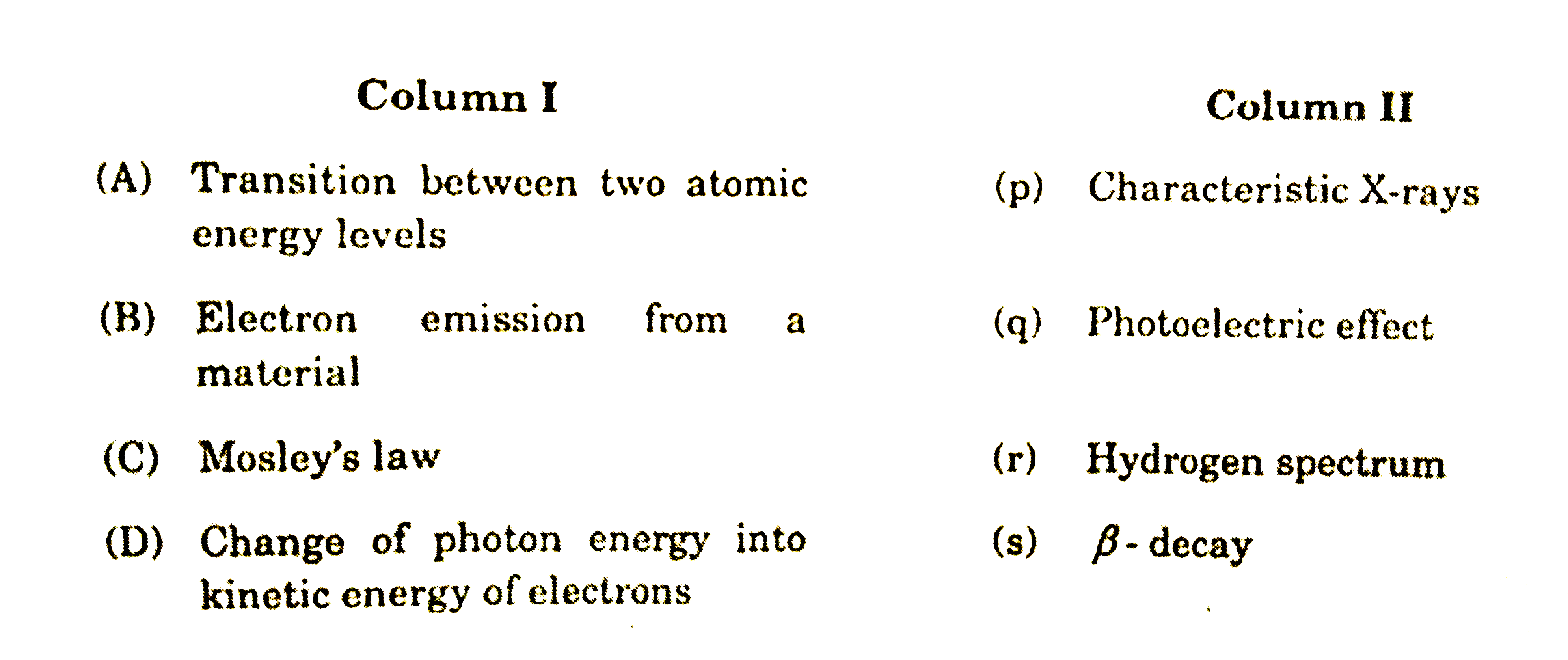Some laws/processes are given in column-I. Match these with the physical phenomena given in column-II.
Column IColumn II(A)Nuclear fusion(p)Converts some matter in energy(B)Nuclear fission(q)Generally possible for nuclei with low aoimic number.(C)β−decay(r)Generally possible for nuclei with high. atomic no.(D)Exothermic nuclear reaction(s)essentially proceeds by weak nuclear forces.
The correct Answer is:(A) p,q (B) p,r (C) p,s (D) p,q,r
Step by step video, text & image solution for Some laws/processes are given in column-I. Match these with the physical phenomena given in column-II. {:(,"Column I",,"Column II"),((A),"Nuclear fusion",(p),"Converts some matter in energy"),((B),"Nuclear fission",(q),"Generally possible for nuclei with low aoimic number".),((C),beta-"decay",(r),"Generally possible for nuclei with high. atomic no".),((D),"Exothermic nuclear reaction",(s),"essentially proceeds by weak nuclear forces".):} by Physics experts to help you in doubts & scoring excellent marks in Class 12 exams.
Topper's Solved these Questions
- BOOK - ALLENCHAPTER - SIMPLE HARMONIC MOTIONEXERCISE - Exercise - 092videos
SIMPLE HARMONIC MOTION
- BOOK - ALLENCHAPTER - SIMPLE HARMONIC MOTIONEXERCISE - Exercise - 102videos
SIMPLE HARMONIC MOTION
- BOOK - ALLENCHAPTER - SIMPLE HARMONIC MOTIONEXERCISE - Exercise - 072videos
SIMPLE HARMONIC MOTION
- BOOK - ALLENCHAPTER - RACEEXERCISE - Basic Maths (Wave Motion & Dopplers Effect) (Stationary waves & doppler effect, beats)25videos
RACE
- BOOK - ALLENCHAPTER - TEST PAPEREXERCISE - PHYSICS4videos
TEST PAPER
Similar Questions
Some lawa I processes are given in Column I. Match these with the physical phenomena given in Column II and indicate your answer by darkening appropriate bubbles in the 4×4 matrix given in the ORS.
 View Solution
View SolutionMatch the columns :
Column IColumn II(1)Polluting energy(a)Soot particles(2)Eco-friendly energy(b)Thermal energy(c)Nuclear energy(c)Wind energyView Solution
Knowledge Check
- Question 1 - Select One
Match the elements given in column (I) with the most appropriat expected values given in column II
Column IColumn IIElementElectronegative valuesA.F(p)3.5B.O(q)3.0C.N(r)4.0D.C(s)2.5AA(r ), B(p),C(q),D(s)BA(s),B(q),C(r ),D(p)CA(p),B(q),C(r ),D(s)DA(r ),B(q), C(p),D(s) - Question 2 - Select One
Match the organisms given in column I with the processes given in column II:
Column IColumn II(i)Leech(a)Holozoic nutrition(ii)Amoeba(b)Autotrophic nutrition(iii)Mushroom(c)Parasitic nutrition(iv)Green plant(d)Saprophytic nutritionA(i) c (ii) a (iii) d (iv) bB(i) d (ii) a (iii) c (iv) bC(i) c (ii) b (iii) d (iv) aD(i) d (ii) a (iii) b (iv) c
Match the anionic species given in Column I that are present in the ore (s) given in Column II.
Column IColumn IIA.Carbonatep.SideriteB.Sulphideq.MalachiteC.Hydroxider.BauxiteD.Oxides.Calaminet.ArgentiteView SolutionMatch the extraction processes listed in Column I with metals listed in Column II.
Column IColumn II(A)Self reduction(p)Lead(B)Carbon reduction(q)Silver(C)Complex formation and displacement by metal(r)Copper(D)Decomposition of iodide(s)BoronView SolutionMatch the extraction processes listed in Column I with metals listed in Column II.
Column IColumn IIA.Self reductionp.LeadB.Carbon reductionq.SilverC.Complex formation and displacement by metal r.CopperD. Decomposition of iodides.BoronView SolutionSome laws/processes are given in Column I. Match these with the physical phenomena given in Column II and indicate your answer by darkening appropriate bubbles in the 4×4 matrix given in the ORS.
Column IColumn II(A)Transition between two atomic energy levels(P)Characteristic X-rays(B)Electron emission from a material(Q)Photoelectric effect(C)Mosley’s law(R)Hydrogenspectrum(D)Change of photon energy into kinetic energy of electrons(S)β−decayView SolutionMatch the conversions in Column I with the type(s) of reaction(s) given in Column II.
Column IColumnIIA.PbS→PbOp.RoastingB.CaCo3→CaOq.CalcinationC.ZnS→Znr.Carbon reductionD.Cu2S→Cus.Self-reductionView SolutionMatch the anionic species given in Column I that are present in the ore (s) given in Column II.
Column IColumn IIA.Carbonatep.SideriteB.Sulphideq.MalachiteC.Hydroxider.BauxiteD.Oxides.Calaminet.ArgentiteView Solution

